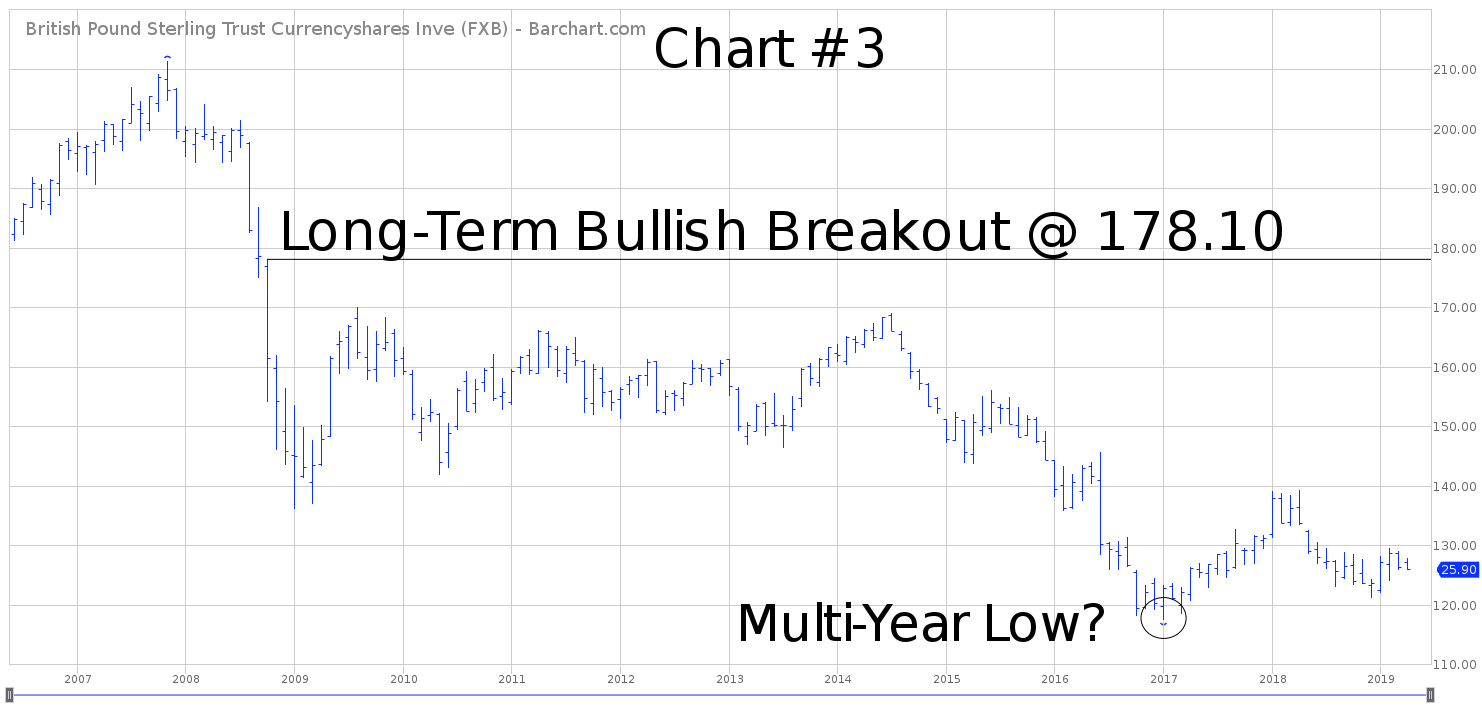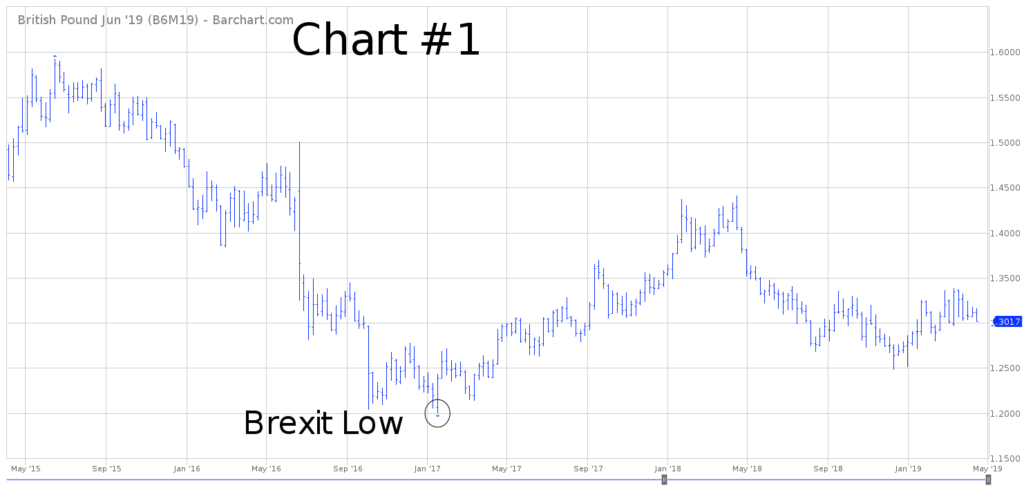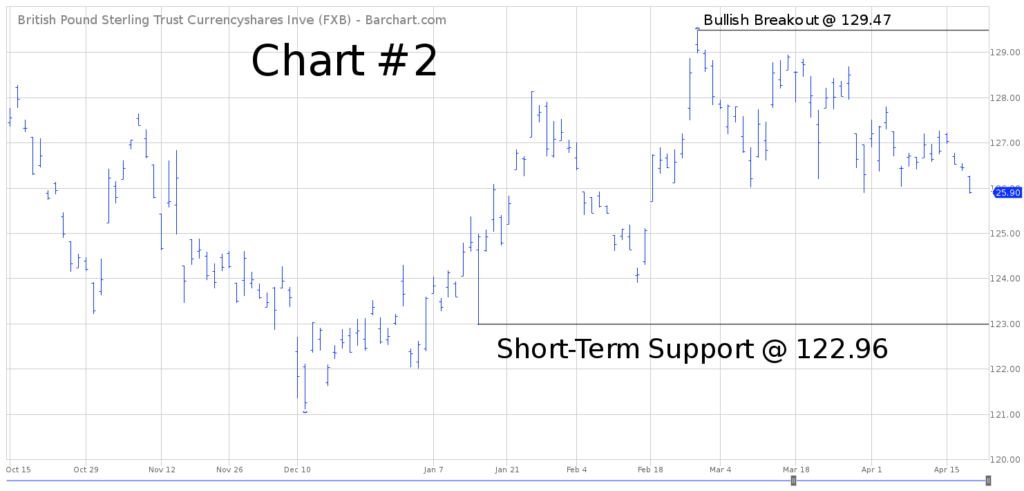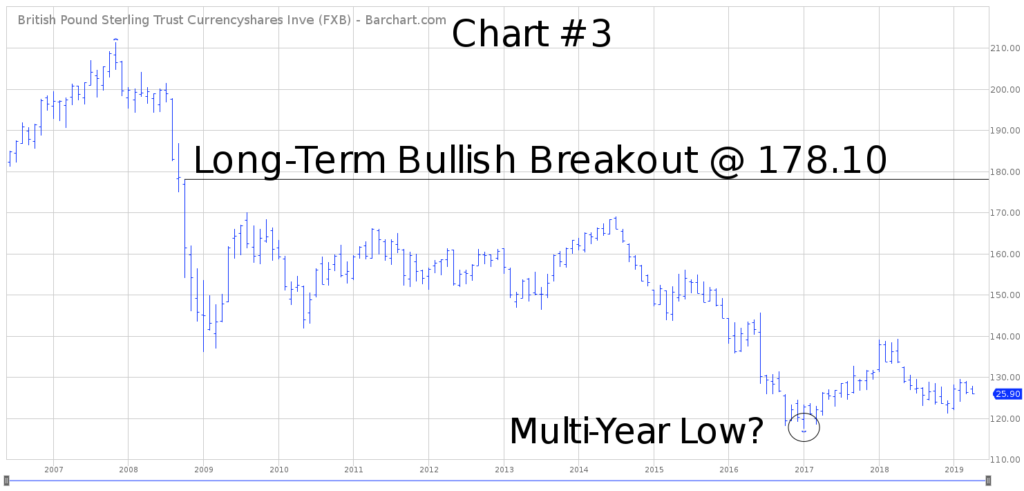

Invesco CurrencyShares British Pound Sterling Trust (FXB) – Daily Report for Apr 22nd
Key Statistics
Minor Support Level 122.96 Minor Resistance Level 129.47
Major Support Level 120.57 Major Resistance Level 178.10
Minor Buy Signal 131.22 Minor Sell Signal 121.10
Major Buy Signal 182.45 Major Sell Signal 117.48
BRIEF OVERVIEW – FXB ETF
On 23 June 2016, the citizens of Great Britain shocked the global financial community by voting to leave the European Union (EU). Wall Street economists and international currency traders claimed that Great Britain’s decision to leave the EU (colloquially known as Brexit) would have devastating consequences to the future value of the British Pound. In fact, some financial historians have postulated that Brexit would cause more damage to Great Britain’s currency than the Bretton Woods agreement of the early-1940s, when the Pound became pegged to the US Dollar.
Essentially, the Bretton Woods agreement was the “beginning of the end” of Great Britain’s dominance in regard to economic superpower and the British Pound’s role as the global reserve currency. Currency traders are betting heavily that Brexit will force the British Pound to move sharply lower over the course of the next decade. If this forecast is correct, Great Britain’s economy will definitely be negatively impacted, particularly as it relates to global trade, domestic inflation and gross domestic product (GDP).
Will Great Britain’s currency suffer a dramatic devaluation during the next 5 to 10 years? More importantly, will the British Pound cause Great Britain’s economy to slip into a multi-year recession? Let’s examine the facts in an effort to answer these important questions. Investors who are able to accurately forecast the direction of the British Pound during the next decade, will definitely enjoy an outsized rate of return.
The Invesco family of exchange-traded funds launched the CurrencyShares British Pound Sterling Trust on 21 June 2006, using the ticker symbol FXB. As the name implies, FXB is not an exchange-traded fund as defined by the Investment Company Act of 1940. Instead, it was established as a grantor trust, with the Bank of New York Mellon acting as the trustee of the trust. Although FXB is not legally registered as an exchange-traded fund, it trades in exactly the same manner as an ETF. As far as investors are concerned, there is no difference between a grantor trust and an ETF.
SHORT-TERM VIEW – FXB ETF
From a short-term perspective, FXB has been locked in a trading range. Consequently, the short-term view is neutral. The important numbers to watch are 122.96 and 129.47. Currently, the bullish camp has a slight edge over the bears. Therefore, the most likely scenario is a penetration of 129.47.
Based on the Aroon Oscillator, FXB has a moderately oversold reading of -55. The Aroon Oscillator is programmed differently than most stochastic indicators. The oscillator fluctuates between -100 and +100. A reading of 0 would indicate a neutral position. Therefore, a reading of -55 with FXB is considered moderately oversold. Most likely, the market is very close to a short-term bottom. In fact, the bottom may have occurred @ 125.87 on 18 April.
LONG-TERM VIEW – FXB ETF
Arguably, the British Pound (officially known as the Pound Sterling) has been the most stable currency in the history of fiat currencies dating back to 775 AD. The Pound Sterling is the world’s oldest currency still in use and which has been in continuous use since its inception. During the past 1,200 years, the currency has managed to survive recessions, depressions, world wars, high levels of inflation, chronic unemployment, government turmoil, monetary crises and global currency devaluations. The British Pound has certainly stood the test of time.
Between 1860 and 1944, the Pound Sterling was the official reserve currency in terms of international trade and balance of payments between countries. The Pound was considered to be the most stable, liquid and trustworthy currency among all industrialized countries for the better part of 80 years. As we discussed briefly, the Bretton Woods agreement formally ended the Sterling’s role as the global reserve currency, to be replaced by the US Dollar.
More recently, the British Pound has found itself in another potentially disruptive storyline. By a vote of 51.9% to 48.1%, the citizens of Great Britain voted to leave the European Union. The vote took place on 23 June 2016. The official exit date was scheduled for 29 March 2019. However, negotiators from Great Britain and the European Union (EU) were unable to reach an agreement concerning a specific exit strategy prior to the 29 March deadline. Therefore, both sides agreed to file an extension in order to work out the details which would allow Great Britain to remove itself from the EU with as little economic disruption as possible. The new Brexit deadline is scheduled for 31 October 2019.
The vast majority of currency experts and Wall Street economists are forecasting a dramatic decline in the value of the British Pound (particularly against the US Dollar) when Great Britain officially removes itself from the EU. However, these bearish predictions of a sharp drop in the Pound Sterling have not come to fruition. In fact, the Pound is much higher today versus the important low that it established in early-2017, following the Brexit vote.
Please review the attached chart of the British Pound (Chart #1). This chart includes four years of historical data. As you can see, the Pound did experience a “knee jerk” reaction to the downside which lasted about six months following the June 2016 Brexit vote. This decline culminated with an important low in January 2017 @ $1.2001 per British Pound. Following this important low, the Pound has traded between $1.20 and $1.44 during the past 2 ½ years. Currently, the British currency is directly in the middle of the range @ $1.30.
What happened? Why didn’t the British Pound collapse following the Brexit vote? Why were so many currency experts completely wrong about the direction of Great Britain’s currency? There are probably several reasons why the British Pound has remained fairly stable since the Brexit vote. However, the main reason why the Pound Sterling has avoided a massive decline is because Great Britain has been building trade relationships with other countries outside of the European Union. Please review the following tables.
Great Britain Trading Partners
Exports and Imports
Country Exports #1 Exports #2 Exports #3 Exports #4 Exports #5
England USA DEU FRA NET IRL
Northern Ireland IRL USA CAN FRA DEU
Scotland NET USA DEU CHN FRA
Wales DEU FRA USA IRL NET
Note Canada (CAN) | China (CHN) | France (FRA) | Germany (DEU) | Ireland (IRL) | Netherlands (NET)
Norway (NOR) | United States
Great Britain Trading Partners
Exports and Imports
Country Imports #1 Imports #2 Imports #3 Imports #4 Imports #5
England DEU CHN NET USA FRA
Northern Ireland IRL USA CHN NET DEU
Scotland NOR CHN USA DEU NET
Wales USA DEU CHN NOR NET
Note Canada (CAN) | China (CHN) | France (FRA) | Germany (DEU) | Ireland (IRL) | Netherlands (NET)
Norway (NOR) | United States (USA)
Great Britain (also known as the United Kingdom) consists of four different countries. The list includes England, Northern Ireland, Scotland and Wales. Over the course of the past decade, Great Britain has been slowly reducing its dependence on the European Union in terms of economic trading of goods and services. As you can see from the charts, Great Britain has a healthy trading relationship with the United States, China and Canada. In fact, 19% of all UK exports are sent to the United States and Canada.
In addition to USA, China and Canada, Great Britain exports its goods and services to Switzerland, Hong Kong, UAE, Turkey, Japan and South Korea.
Top 15 Exporting Countries
- United States 13.3%
- Germany 9.7%
- Netherlands 6.9%
- France 6.6%
- Ireland 5.9%
- China 5.7%
- Switzerland 5.2%
- Belgium 4.0%
- Italy 2.9%
- Spain 2.9%
- Hong Kong 2.1%
- United Arab Emirates 2.1%
- Turkey 2.0%
- Japan 1.7%
- South Korea 1.6%
In terms of Great Britain’s top 15 exporting countries, 9 of the countries are located outside of the European Union. In percentage terms, 33.7% of United Kingdom exports are conducted with non-EU members. Consequently, the UK has plenty of export diversification outside of the European Union. This is the main reason why the British Pound will not collapse when Brexit officially occurs (probably on 31 October).
In regard to the long-term view of FXB, the bears definitely have control of the momentum. Essentially, the ETN has been drifting lower since November 2007. In order to reverse the momentum, bulls need a weekly close above 178.10. A strong argument could be made that FXB recorded an important bottom @ 117.48. However, at least for now, the bears have the upper hand.
SHORT-TERM CHART – FXB ETF
Please review the 6-month chart of FXB (Chart #2). Based on the short-term chart pattern, FXB has been locked in a trading range. Consequently, the short-term trend is neutral. The important numbers to watch are 122.96 and 129.47. The current chart formation would suggest an eventual breakout to the upside. Therefore, the most likely scenario is a penetration of 129.47.
LONG-TERM CHART – FXB ETF
Please review the 13-year chart of FXB (Chart #3). This chart covers the entire trading history of FXB. Clearly, the long-term chart pattern is bearish. The ETN has been drifting lower since November 2007. However, it does appear that an important bottom was formed in January 2017. This would match perfectly with the original Brexit vote in June 2016. It’s not uncommon for a major asset class (like a global currency) to form a big reversal following an important event or historical milestone. Therefore, January 2017 may have marked the beginning of a multi-year advance in FXB.




